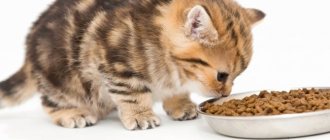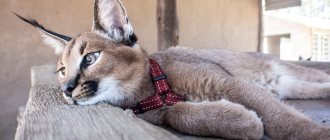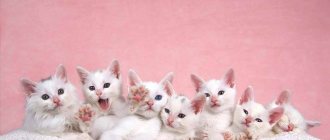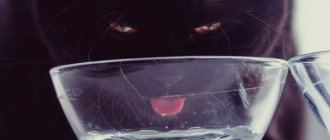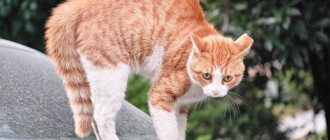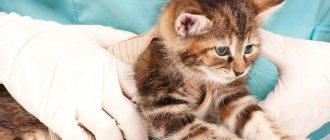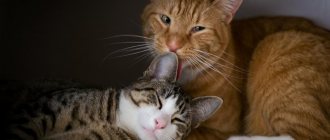During a cat's pregnancy, owners, especially those who are experiencing this for the first time, have a lot of questions regarding her health and care. Another important question is: how many kittens can a cat give birth to, in order to know what to prepare for, and, perhaps, already look for their future owners.
How many kittens can a cat give birth to?
If we consider averages, then an ordinary cat can give birth to 6-8 babies at a time. However, the number of cubs is not just the will of fate, but a confluence of many factors. There is a case in history when a representative of the Persian breed gave birth to 15 kittens at once. It is also not uncommon for 1-2 babies to be born. So, what will determine the number of future babies?
Features of the female body
How many kittens a cat gives birth to depends, first of all, on the characteristics of her body. The first birth is usually a surprise, and then the owners know roughly what to expect from their pet. What will affect the female's fertility:
- Age
: Primiparas and late-parous women are unlikely to have many babies. Most likely there will be about 1-2 cubs.
- Genetics
: if the cat’s mother was fertile, then the daughter will most likely inherit this quality.
- Size
: a miniature cat, even in its prime, will not bring too many kittens, but a large and well-fed female is capable of regularly giving birth to a large number of babies.
- Health
: if the cat has any problems, then she will bring significantly fewer kittens.
If you know the cat’s mother and this is not the first time you have observed childbirth, then it will not be difficult to determine the approximate number of fetuses even without an ultrasound.
Male fertility
The number of offspring is influenced by the characteristics of your cat's partner. For example, his age: if the cat has not reached 1.5-2 years of age or, conversely, is too old, the quality of his semen will be an order of magnitude lower than that of strong and healthy cats. Pay attention to the frequency of matings of the cat - you should not expect a large litter if he fertilizes more than 4 cats per year.
The father's health is undoubtedly one of the most important factors. Infectious diseases or diseases associated with the reproductive system can affect not only the number and condition of the offspring, but also the health of the mother herself. If you have a purebred cat and are looking for a mating partner, be sure to ask for a health certificate, the necessary documents on purebred, and also ask the owners how many kittens are usually born from a given male.
An amazing feature is characteristic of cats - in one litter there can be fruits from completely different fathers. This is due to the fact that eggs in the body are produced directly during mating. Therefore, outdoor cats produce more kittens than planned breeding pets.
Dependence on breed
Without a doubt, the fertility of a furry mother is also influenced by her breed. Surely you have noticed that ordinary street cats often give birth more than indoor cats? This is due to a simple truth - harsh conditions await children on the street, and the chances of survival are much less than at home. Therefore, to continue the race, a larger number of kittens is needed.
Purebred pets are not so fertile. For example, Scottish women give birth to an average of two or three babies at a time, but British representatives are already capable of bearing 4-5 babies. However, not everyone can master even this breed maximum.
What does (low) multiple pregnancy depend on?
Young cats give birth to 1 to 3 kittens for the first time.
There are both a huge number of hypotheses and scientifically proven facts on this matter. Our topic is not a dissertation for an academic degree, so we will lump all theories and evidence into one common pile.
Proper and nutritious nutrition has an important influence on conception, subsequent pregnancy and childbirth: the worse a cat eats, the less likely it is to become pregnant. There is such a thing as nutritional infertility - in this way nature tries to prevent the appearance of non-viable or sick offspring. The weight of the pet also plays an important role in the production of eggs and subsequent pregnancy.
It is well known that obese females not only do not become pregnant, but they, in principle, do not go into estrus - what kind of multiple pregnancy can we even talk about in this case? Conditions of keeping: comfort, warmth, cleanliness, lack of stress, etc. Hereditary factor: if a cat was born from a low-fertility mother, then the likelihood that she will produce “a little” kittens is very high! A history of infectious diseases that somehow affect the development of reproductive function. Diseases of the reproductive system and injuries also affect the number of eggs produced. The temperament of a cat, no matter how strange it may sound. After all, it is well known that ovulation in cats occurs at the moment of coitus, and the sexier the male is, the more he cares for the bride, the more eggs will be released. Incompatibility with the opposite sex, which also occurs in humans. So, for example, there lived an allegedly infertile cat who was in heat, and they bred her with three different cats, but there was no effect. Until her permanent fiancé appeared in her living space. Apparently, the every minute presence of the cat, its smell, awakened hidden possibilities in the “woman’s” body. Let’s remember once again about cats, or more precisely about the quality of their sperm. The weaker the sperm, the smaller their number, the more underdeveloped among them, the less the chance of getting healthy, and most importantly, multiple offspring from a healthy cat. In turn, the quality of sperm depends on the nutrition of the reproductive system and the frequency of its use (both excessive use and abstinence have a negative impact on reproductive function). Low hormonal levels of the expectant mother, when the follicles produce few eggs ready for fertilization. Long-term use of antisex hormones will not only affect the number of offspring, but also its viability. Most often, a cat mated after such therapy brings 1-2 kittens, while they are weak or not at all capable of life outside the womb. Individual characteristics of the body, size, weight, age, etc., etc. Breed is another factor. For example, outbred cats can give birth to many kittens in the first, subsequent, and very last pregnancies. Whereas animals of blue blood rarely bring more than 5. It is believed that the number of matings affects the number of kittens. Allegedly, after the first mating, the animal brings 1-2 kittens, by the seventh it reaches its natural maximum, and after that the number of offspring decreases again. Another theory, more like nonsense, says: the sooner insemination occurs from the start of estrus, the more kittens will be born.
If the cat is pregnant for the first time
Owners often wonder if a cat can give birth to one kitten? If your pet is pregnant for the first time, it is unlikely that her litter will be large. Most likely, 2-3 kittens will be born, or even just one.
The fact is that the cat's reproductive system can only be fully formed after the first pregnancy. A future furry mother can become pregnant as early as 8 months, but this does not mean that such an early pregnancy is desirable. At the age of up to 1 year, her body is so delicate that carrying even one fetus is a risky step. Here it is important to determine not how many kittens a cat gives birth to for the first time, but how she will cope with motherhood and whether her health will be undermined.
Of course, in nature no one keeps track of when cats mate or don’t mate. But at home, a caring owner should not allow early mating at least until 1.5-2 years.
Fertility of different breeds
Typically, a cat gives birth to 6–8 kittens during one pregnancy. Records also happen. There is a known case when a Persian cat was able to give birth to 15 kittens at once. However, with a large litter, there is a high probability of dead or non-viable babies. Newborns have too little body weight and, moreover, the cat does not have enough milk to feed large offspring.
The record holder for the number of kittens is a tabby cat from the USA. She gave birth to 420 furry babies. This is the absolute maximum.
It is also interesting to know what kind of offspring cats of different breeds have. For example, a purebred Scottish cat can give birth to 2-3 babies. A larger number (up to will be if the father is not purebred.
For example, a purebred Scottish cat can give birth to 2-3 babies. A larger number (up to will be if the father is not purebred.
British cats have a higher average fertility. A cat usually gives birth to 4–5 kittens per lamb. But not every representative of this breed can give birth to the maximum.
Minimum and maximum
Surely your cat periodically gives birth to 4 to 6 kittens - this is the average for representatives of all breeds. There are also cases of the birth of 8 or more cubs. The fact is that a furry mother has a certain limit - a certain number of babies that she can feed. Their number should not exceed the number of her nipples. If there are more than eight kittens, one will not get milk, which means the baby may die. Then the owners will have to help the young mother feed her offspring.
The minimum number of kittens is one; there are cats that, due to genetic and physiological characteristics, are not able to conceive and bear a large number of fetuses. If your cat usually gives birth to around five babies and suddenly gives birth to one, you should take her to the vet - there is most likely something wrong with her health.
How many kittens can a cat give birth to maximum? It’s hard to say, the known documented limit is 15 pieces. But in general, the number of kittens over 10 is already rare. In purebred animals, the threshold is even lower - they rarely reproduce more than 6 kittens.
An older mother will no longer give birth to the same large litter as in her best years. The reproductive system wears out over time, and the likelihood of a difficult pregnancy increases. It is better to protect your cat from mating after reaching 8-10 years of age.
How to determine the number of kittens in a pregnant cat
If you want to find out how many kittens a cat will give birth to, there are several proven methods:
- Based on genetic data. How many babies did your pet's mother have in her litter on average? Most likely, this factor was inherited from her. If the cat's grandmother had an average of 6 goals at a time, then your pet will have the same number. She is unlikely to give birth to more than her ancestors gave birth to.
- Folk way. Count how many mammary glands the cat has swollen during pregnancy? Then subtract two from their number. Of course, no one can guarantee the effectiveness of such a result, but it is used quite often.
- Scientific method. One of the simplest and most common ways to find out how many kittens a cat will give birth to today is ultrasound. It is done 10-14 days before birth, this will allow you to determine the exact number of fetuses.
Under no circumstances should you try to count the number of fetuses in a pregnant cat by palpating her. This can affect the health of future babies and cause stress for the mother herself. The maximum that can be done is to gently stroke the tummy if the cat exposes it herself.
Keep a close eye on your pet. If she had more than one partner at the beginning of her pregnancy, then she is likely to give birth to both fathers, which means that the number of cubs will be greater than usual.
Cat pregnancy
Normally, pregnancy in most breeds lasts 63 days, but deviations up or down by 3 days are possible, and this is not a pathology. A month after the start of conception, when stroking the belly, you can already feel the kittens. But it is impossible to determine the quantity in this way, since they are very small - barely reaching 3 cm in length.
Gradually, the cat's belly begins to grow. From the 5th week, it is not recommended to probe the abdominal wall of your pet for a long time and often, as this can harm the normal course of pregnancy.
If the owner is impatient to find out about the number of future offspring and its condition, an ultrasound can be performed at a veterinary clinic.
From the 6th week of pregnancy there is a significant increase in the size of the expectant mother’s belly, and after another 7 days, when you put your hand on it, you can feel the kittens actively moving in the womb.
In the last week, it is already difficult for the cat to move, she rests a lot and begins to look for a secluded place where she will give birth. Therefore, it is worth preparing in advance for this process, which can begin any day. You need to find and put a large box in a secluded place so that the pet can safely give birth to babies and live with them there for some time.
We recommend an article about the duration of a cat's pregnancy.
How to increase the number of kittens in a litter
This question is most often asked by those owners who are planning to breed and breed a purebred pet. It is important to understand that this is not a simple matter at all, since any mistake can have a detrimental effect on the health of the animal. Be careful not to cause any harm.
The main way to increase fertility, of course, is medications. First of all, you should pay attention to homeopathic remedies. Now in almost every pharmacy you can find at least several products that are not harmful to your pet’s health. Especially notable among them are Gamavit and Ovariovit - these drugs have a beneficial effect on the reproductive system of the expectant mother and help eggs to form in large volumes.
You can contact your veterinarian and consult with him about taking supplements such as selenium and vitamin E. Only a specialist can prescribe exact dosages based on the breed, condition and physiology of the expectant mother. Under no circumstances should you give your cat supplements yourself, otherwise there will be a risk of metabolic disorders and the development of diseases on this basis.
The process of preparing your pet for pregnancy should begin long before mating. If she is already pregnant, there is no point in doing anything.
Is it better to have a little or a lot?
Definitely, every owner wants his purebred pet to produce as many furry babies as possible. But it is important to observe moderation - the more fetuses in the womb of an animal, the higher the likelihood of complications during childbirth. This is especially true for young individuals and those who are already aged.
Even a healthy cat is unlikely to be able to feed a litter that is too large. Not only will the babies squeeze all the juices out of it, but there is also a high probability that there will not be enough mother’s milk for everyone. Too much pregnancy often leads to the death of part of the litter in the womb, because the cat’s body cannot cope with such a colossal load.
If a mother gives birth to only a few babies, this risks one of them getting stuck in the birth canal, from where it is usually pushed out by a whole line ready to be born. The fact is that kittens born alone or with 1-2 brothers are an order of magnitude larger than usual. If such an incident occurs, the mother needs an urgent caesarean section, otherwise she may die along with the baby. Excess milk in the glands can also lead to unfavorable events - for example, mastitis.
Of course, the golden mean is the ideal option. It is much better if a pet gives birth to 4-6 healthy ones than 10 weak babies that she cannot even feed. For the most purebred representatives, their own health is much more important than the excessive number of litters - after all, if any serious problems arise, there may be no offspring at all.
Features of pregnancy and preparation for childbirth
Pregnancy in cats lasts on average 63-65 days. By the middle of the term, a noticeable belly grows. When stroking, you can feel that it is dense and slightly elastic. After another week, the fruits can already be felt a little. It is better to entrust this to a doctor, because under no circumstances should you press too hard or for too long. At this stage, the kittens are already beginning to descend into the lower abdomen.
Over the course of 6-7 weeks, the belly grows a little more, and the mother begins to prepare for childbirth. Now, if you put your hand on her stomach, you will clearly feel something moving inside. From the 8th week until the birth, the mother cat no longer has the strength to move, so make sure that she has a quiet and calm place somewhere in a wide basket or box. Bring her food and water.
During childbirth, you can help your pet by lightly stroking her belly from top to bottom. But in general, childbirth goes quickly and without complications. After it's all over, leave her alone with the kids.
Do you like the article? 503
Caring for the expectant mother
It is necessary to begin preparing for childbirth after it is confirmed that the cat is pregnant. First of all, you need to monitor nutrition and take a closer look at the animal’s daily routine.
If the expectant mother is surrounded with care and attention, then the pregnancy will go smoothly and successfully
Proper nutrition
During the entire gestation period, the cat's appetite changes. She may eat a lot or refuse to eat at all. Obesity will lead to difficulties during childbirth, so the expectant mother should not be overfed, nor should she be starved. There are general recommendations that will help you establish a proper diet:
- In the early stages of pregnancy, the usual portion of the pet increases by 10%, and in the period from the third to the sixth week it doubles. Then it is better to return to normal volumes.
- It is better to feed the cat 4-5 times starting from the second week, and introduce three meals a day after the sixth week of pregnancy.
- There is no need to suddenly change the diet of a pregnant cat. If she ate industrially produced food, then she needs to continue to feed the same (do not change the manufacturer), but labeled “for pregnant women.” If the diet was normal, then additionally cottage cheese, lean meats, vegetables, and yogurt are added to the diet.
- You should definitely talk to your veterinarian about taking vitamins. Some foods contain vitamins, but not all. A specialist will help you understand this issue.
Content Rules
The expectant mother needs to get plenty of rest and avoid strenuous physical activity. It is better to protect her from all situations that could lead to overexertion, for example, communication with active children. By observing the following rules, you can create the most comfortable conditions for your cat:
- During the entire pregnancy, it is better to protect your pet from independent walks on the street.
- The cat needs help with personal hygiene, especially in the later stages, when she can no longer reach hard-to-reach places on her own. It is necessary to wipe the genitals and tail with a damp sponge.
- To eliminate the danger of obesity, you need to play with the expectant mother, while controlling the load.
- A cat can sleep a lot. There is no need to wake her up, this way she saves vitality.
If in the late stages of pregnancy the cat often licks itself, becomes nervous, and rapid breathing is noticed, it means that the first stage of labor has begun. She will spend the entire second stage in the nest that she has previously chosen
Usually cats successfully cope with childbirth on their own, but excessive attention from others can be harmful and cause stress. So it's better to leave her alone
If you provide your pet with timely examination and proper care, then the little lumps will be born healthy and on time.




